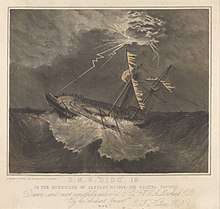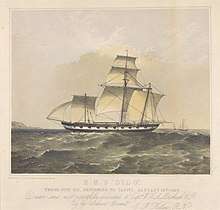HMS Dido (1836)
HMS Dido was an 18-gun Daphne-class corvette built for the Royal Navy during the 1830s.
_casting_from_Spithead_1841_-_RMG_PY0869.jpg) HMS Dido at Spithead 1841 | |
| History | |
|---|---|
| Name: | Dido |
| Namesake: | Dido |
| Ordered: | 26 February 1834 |
| Builder: | Pembroke Dockyard |
| Laid down: | September 1834 |
| Launched: | 13 June 1836 |
| Completed: | 26 January 1837 |
| Commissioned: | 25 October 1836 |
| Fate: | Sold for scrap, 3 March 1903 |
| General characteristics | |
| Class and type: | Daphne-class corvette |
| Tons burthen: | 734 10/94 bm |
| Length: | |
| Beam: | 37 ft 8 in (11.5 m) |
| Draught: | 14 ft 4 in (4.4 m) |
| Depth: | 18 ft (5.5 m) |
| Complement: | 145 |
| Armament: | 18 × 32-pdr cannon |
Description
Dido had a length at the gundeck of 120 feet (36.6 m) and 99 feet (30.2 m) at the keel. She had a beam of 37 feet 8 inches (11.5 m), a draught of 14 ft 6 in (4.4 m) and a depth of hold of 18 feet (5.5 m). The ship's tonnage was 734 10⁄94 tons burthen.[1] The Daphne class was armed with eighteen 32-pounder cannon. The ships had a crew of 145 officers and ratings that later increased to 175.[2]
Construction and career
Dido, the second ship of her name to serve in the Royal Navy,[3] was ordered on 26 February 1834, Designed by Symonds, laid down in September 1834 at Pembroke Dockyard, Wales, and launched on 13 June 1836.[2] She was completed on 26 January 1837 at Sheerness Dockyard and commissioned on 25 October 1836.[1]
In May 1843 Dido's crew were manning the proa Jolly Batchelor, which belonged to Rajah Brooke of Sarawak, when they were attacked by two Lanoon pirate proas off Datto Point, Borneo at 3 am. The encounter ended in the destruction of one proa and the elimination of the crew of the other.[4]
Dido arrived at Auckland, New Zealand from the East Indies Station on 2 June 1847.[5]


She took part in Syrian war of 1840 and Chinese war of 1842.[6] On 9 April 1852, she ran aground on the Wellsbank, off Callao, Peru.[7] On 28 July 1852, she ran aground off Tahiti, damaging her forefoot and keel. She was ordered back to England for repairs.[8] In Pacific 1855. She was used as a coal hulk after 1860, at Sheerness and was sold in 1903.[6]
Notes
- Winfield, p. 931
- Winfield & Lyon, p. 120
- Colledge, p. 97
- "The Attack of two Lanoon Pirate Proas on the Proa 'Jolly Batchelor'". Royal Museums Greenwich. Retrieved 31 March 2018.
- Cowan, James (1922). "Chapter 9: The Capture of Rua-Pekapeka". The New Zealand Wars: a history of the Maori campaigns and the pioneering period, Volume I: 1845–1864. Wellington: R.E. Owen. pp. 73–87.
- Wooden rectangular plaque for the full hull model of HMS Dido (1836), an 18 gun sixth rate sloop.
- "West India and Mexican Mails". Daily News (1873). London. 24 May 1852.
- "Shipping Intelligence". The Times (21258). London. 28 October 1852. col B, p. 5.
References
- Colledge, J. J.; Warlow, Ben (2006) [1969]. Ships of the Royal Navy: The Complete Record of all Fighting Ships of the Royal Navy (Rev. ed.). London: Chatham Publishing. ISBN 978-1-86176-281-8.
- Phillips, Lawrie; Lieutenant Commander (2014). Pembroke Dockyard and the Old Navy: A Bicentennial History. Stroud, Gloucestershire, UK: The History Press. ISBN 978-0-7509-5214-9.
- Winfield, Rif (2008). British Warships in the Age of Sail, 1793-1817: Design, Construction, Careers and Fates. Barnsley, UK: Seaforth. ISBN 1-84415-700-8.
- Winfield, R.; Lyon, D. (2004). The Sail and Steam Navy List: All the Ships of the Royal Navy 1815–1889. London: Chatham Publishing. ISBN 978-1-86176-032-6.
External links
